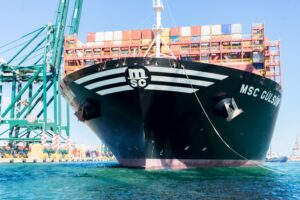
- The Port Authority of Valencia (APV) has begun the process of awarding the project for the installation of electrical connections to ships for the Transversal Costa-MSC quay in the Valencian precinct
- The joint tender for the construction project includes the drafting of the project, the execution of the infrastructures and the maintenance of the installation for a value of 12,468,626.8 euros
- With this procedure, Valenciaport continues to take firm steps towards its goal of becoming an emission-neutral facility by 2030
- The work to supply electricity to the OPS (Onshore Power Supply) ships will be carried out in parallel to the construction of the electrical substation – already underway – which will supply the ships with green energy
- This project is financed by the European Union’s Next Generation funds and the Spanish Government’s Recovery, Transformation and Resilience Plan
València, 7 August 2023 – A new step in the decarbonisation of the Port of Valencia and its firm commitment to be an emission neutral site by 2030. The Port Authority of Valencia (APV) has put out to tender the drafting and execution of the works for the electrical connection to ships for the Transversal Costa-MSC quay. This is the first electrification or Onshore Power Supply (OPS) project to be carried out by Valenciaport in the Valencian precinct.
The APV is thus initiating the procedure for the award of the contract for the drafting and execution of the project for the installation of electrical connections for ships and the maintenance of the same at the Transversal de Costa quay. To this end, Valenciaport has jointly launched the drafting of the construction project, the execution of its works and the maintenance of the installations in the same procedure for an amount of 12,468,626.8 euros (VAT included).
Onshore Power Supply (OPS) electrification infrastructures have been consolidated as a very useful tool for the decarbonisation of ports, as this system avoids the use of auxiliary engines of ships when they are docked in the enclosures. This reduces greenhouse gas emissions – due to the use of electricity that eliminates the consumption of fossil fuels used in these auxiliary engines – and stops the emission of particles and polluting gases.
This OPS initiative in the Port of Valencia will be carried out in parallel with the works on the new electrical substation – a second substation is also planned – which was put out to tender last month with a base budget of around 11 million euros and a completion period of 24 months. This infrastructure will be responsible for supplying green energy to the first OPS electrification project of the Transversal de Costa-MSC quay.
In this regard, Joan Calabuig, president of Valenciaport, stressed that “these are just two examples of real projects in the execution phase that confirm the firm commitment that Valenciaport is making to achieve the goal of being a zero-emissions port by 2030, twenty years ahead of the European Green Pact. It is a commitment to sustainability and to the society of our environment that is supported by initiatives such as the electrification of the docks, the use of hydrogen in port operations, the installation of photovoltaic plants or the commitment to intermodality with the railway. We are committed to sustainable growth that reinforces our position as a port of reference in the Mediterranean”.
Project included in the Next Generation Funds
The joint contracting of the preparation of the project and the execution of the corresponding works in the same procedure is carried out in response to the fact that there are no references in Europe compatible with the ISO/IEC/IEEE 80005 standard and in Spain there is currently no previous experience of OPS projects in operation with the characteristics of the pilot project defined by the Port Authority of Valencia. The combination of the individual components required for this type of installation (transformers, protection cells, disconnectors, frequency converters, etc.) with infrastructures for supplying electricity to ships requires specific projects, with technically complex solutions that have to be designed specifically for each location. In addition, and given that the execution of the construction project is subsidised by the European Union’s Next Generation funds and the Spanish Government’s Recovery, Transformation and Resilience Plan, the joint tender is the only way to meet the established deadlines, since if two separate contracts were launched, the one for the execution of the construction project could not be launched until the one for the drafting of the construction project had been awarded, which would mean that the work would be completed beyond the deadline for the execution of the works to meet the target set by Europe.

